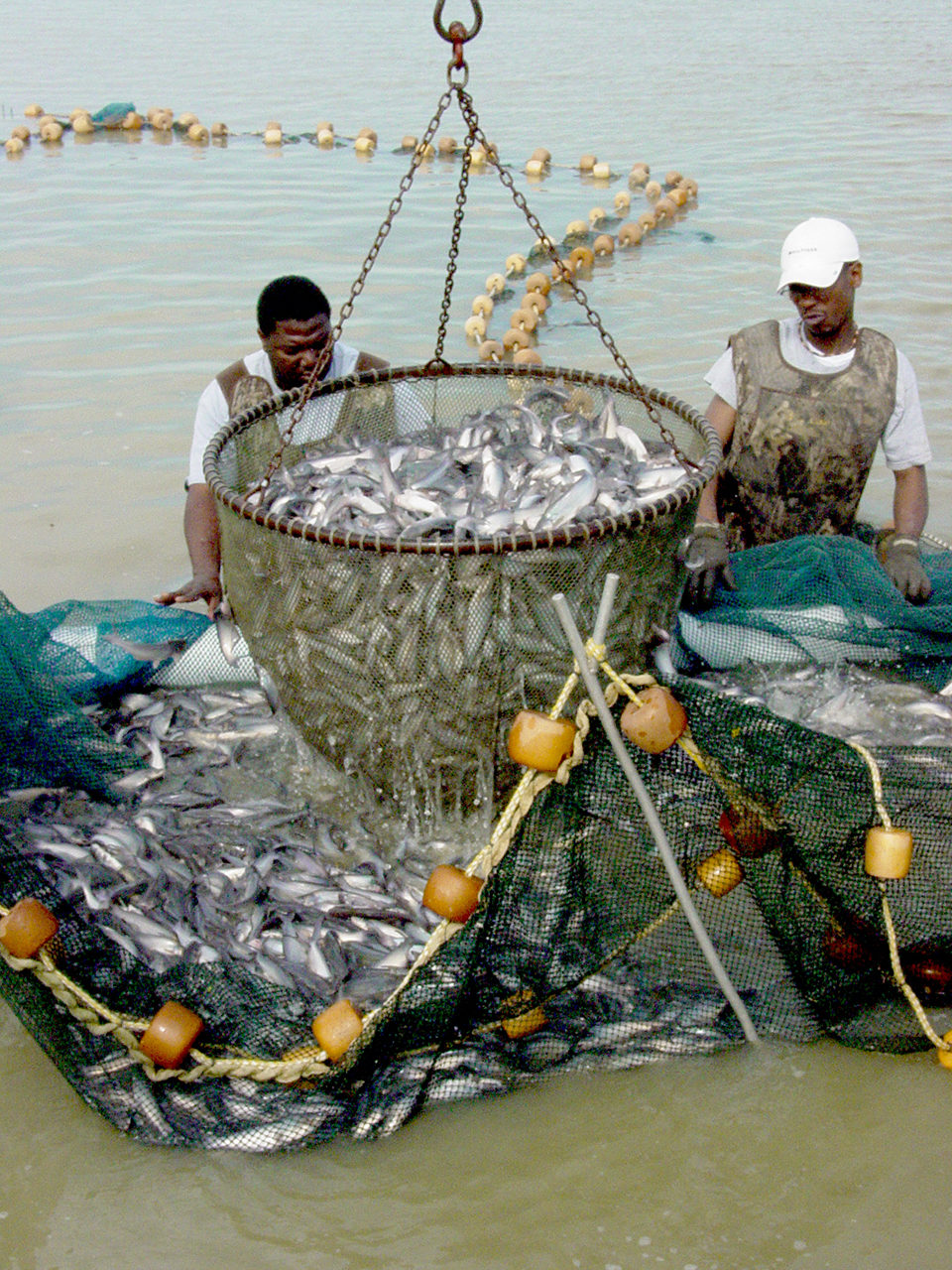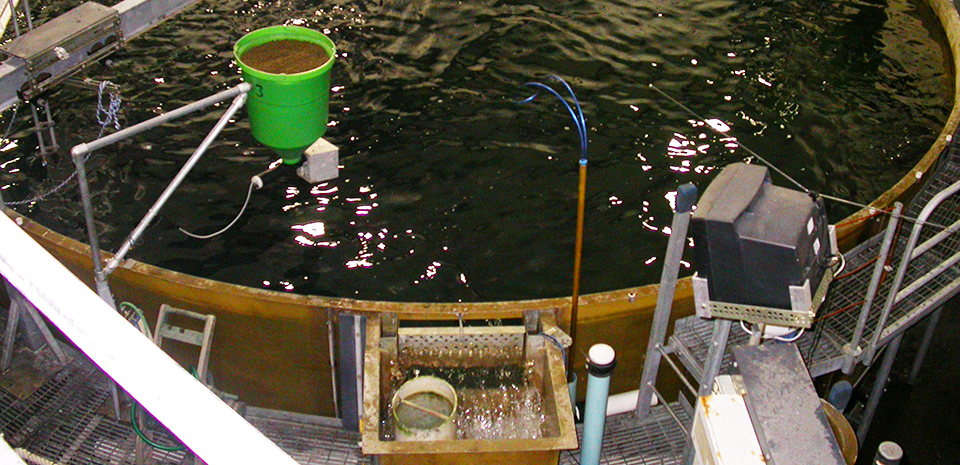Changes over time likely due to variation in quality, inadequate sampling

Aquaculture ponds for channel catfish (Ictalurus punctatus) in the southeastern United States often contain more food-sized catfish than processors can accept at one time. Fish remaining after the initial harvest are returned to the pond and harvested again as soon as possible based upon processor demands.
Some catfish farmers report that catfish crops initially declared “on flavor” appear to develop off-flavors soon after the first harvest, which postpones harvests of the remaining population and delays subsequent production.
Sudden off-flavor
There are at least three possible reasons for fish to suddenly develop off-flavors after seining and harvest. First, the type of phytoplankton in the pond may change to include blue-green algae (cyanobacteria) that produce odorous compounds such as geosmin or 2-methylisoborneol (MIB). Those compounds are quickly absorbed by fish and deposited in flesh, giving fish “earthy” or “musty” off-flavors.
Second, seining a pond can release odorous substances from pond sediments and taint fish. And third, fish remaining after harvest may feed on dead fish or plants, and odorous substances in the decaying material can impart off-flavors to fish after consumption.
The authors conducted an eight-month study to determine whether fish systematically develop off-flavors after partial fish harvest and, if so, to determine the types and origins of the flavors.
Study setup
The study was conducted on a commercial catfish farm in the delta region of western Mississippi. The water source and production practices were typical of other production ponds in the region.
Ponds were sampled in sets of two with each pair sampled over a two-week period under a defined schedule. Water and catfish fillet samples were collected immediately prior to initial harvest. Water samples were collected the day after harvest, and water and fish samples were collected three to seven days after harvest.
Water and catfish samples were again collected 14 to17 days after harvest. Six ponds were sampled over a warm-weather period (July through October), and six ponds were sampled over a cool-weather period (January to early April).
Water samples were analyzed in the laboratory for geosmin and MIB levels, and phytoplankton in pond water samples were identified and counted using microscopy. Catfish fillets were analyzed in the laboratory to quantify geosmin and MIB and were taste tested to determine the quality and intensity of off-flavor.
MIB, geosmin levels
In most ponds, MIB levels decreased or remained unchanged in pond water after the first seining, while geosmin remained at levels below 10 ng/L in all ponds. In four ponds, MIB levels increased the day after seining. However, the MIB in two of those ponds eventually decreased or returned to levels similar to those prior to seining. Based upon sensory analysis, the spikes in MIB levels in those four ponds did not increase the incidence or intensity of musty off-flavors in fish sampled after the initial harvest.
Mean MIB and geosmin levels in catfish fillets from the summer and winter sampling periods were lower or not significantly different after the first harvest. Statistical analysis indicated that MIB levels in catfish fillets decreased or were unchanged after the first harvest, although several individual fish samples contained MIB at or above 200 ng/kg, the sensory detection threshold value for trained taste testers.
Similar results were found for geosmin levels in catfish fillets. Overall, analysis of catfish fillets did not show any systematic increase in mean MIB or geosmin levels following the initial harvest.
Microscopic analyses of water samples showed that Planktothrix perornata, an MIB-producing blue-green alga, was present in only three ponds. The abundance of P. perornata decreased in two ponds after initial harvest and increased in the third pond. This indicated that seining the ponds did not change ecological conditions, thereby causing an increase in odor-producing algae. In addition, seining did not promote conditions leading to enhanced production of geosmin and MIB by actinomycetes (non-photosynthetic bacteria) present in the ponds.
Summer flavor
Taste testing of fish sampled in the summer months identified “musty” as the most common type of off-flavor (Table 1). “Woody” off-flavor was also detected in catfish fillets on a couple of sampling dates. Woody off-flavor has been attributed to β-cyclocitral, another compound produced by blue-green algae and other microorganisms.
Schrader, Results of sensory analysis of catfish fillets, Table 1
| Pond | Sampling Date | Mean Sensory Score | Off-Flavor Fish* | Flavor Description |
|---|
Pond | Sampling Date | Mean Sensory Score | Off-Flavor Fish* | Flavor Description |
|---|---|---|---|---|
| 52 | 7/15/09 | 0.2 | 0 | Cardboard, stale |
| 52 | 7/20/09 | 0 | 0 | None detected |
| 52 | 7/31/09 | 0 | 0 | None detected |
| 169 | 7/15/09 | 2.0 | 4 | Musty, woody |
| 169 | 7/20/09 | 2.2 | 4 | Musty |
| 169 | 7/31/09 | 1.7 | 3 | Musty |
| 86 | 8/17/09 | 0.3 | 0 | Slightly musty |
| 86 | 8/20/09 | 0.2 | 0 | Slightly stale |
| 86 | 8/31/09 | 0.3 | 0 | Slightly musty |
| 301 | 8/17/09 | 0 | 0 | None detected |
| 301 | 8/20/09 | 0.2 | 0 | Slightly musty |
| 301 | 8/31/09 | 0.2 | 0 | Slightly sewage |
| 46 | 9/24/09 | 1.3 | 2 | Musty |
| 46 | 9/28/09 | 1.0 | 1 | Musty, earthy |
| 46 | 10/8/09 | 0.3 | 0 | Woody |
| 160 | 9/24/09 | 0.2 | 0 | Stale, slightly earthy |
| 160 | 9/28/09 | 0 | 0 | None detected |
| 160 | 10/8/09 | 0.2 | 0 | Slightly earthy |
0 = on flavor, 1 = very slight off-flavor, 2 = slight off-flavor, 3 = distinct off-flavor, 4-5 = strong off-flavor.
Table 1. Results of sensory analysis of catfish fillets collected during summer months. Score represents results of six catfish obtained on the sampling date.
Two of the 12 ponds sampled during the summer contained objectionable-tasting catfish prior to initial harvest. Samples from pond 169 possessed an objectionable off-flavor intensity rating of about 2.0 or higher on each sampling date. Pond 46 also contained objectionable fish collected on the first sampling date, but the mean sensory score improved on later sampling dates.
Winter flavor
Flavor testing of catfish obtained during the winter months detected a variety of off-flavors, and four of the 12 sampled ponds contained objectionable off-flavored catfish prior to harvest (Table 2). Off-flavors described as “decay,” “fishy,” “rotten” and “rancid” were probably caused by catfish eating dead fish during the winter – a time when most catfish farmers do not apply manufactured feed, and fish may scavenge for food. Likewise, off-flavors described as grassy or “vegetable” are likely due to fish eating dead or living algae or plants.
Schrader, Results of sensory analysis of catfish fillets, Table 2
| Pond | Sampling Date | Mean Sensory Score | Off-Flavor Fish* | Flavor Description |
|---|
Pond | Sampling Date | Mean Sensory Score | Off-Flavor Fish* | Flavor Description |
|---|---|---|---|---|
| 440 | 1/25/10 | 0.8 | 1 | Earthy, musty, grassy |
| 440 | 2/1/10 | 0.7 | 1 | Musty, woody, rotten |
| 440 | 2/10/10 | 0.8 | 1 | Decay, grassy, woody |
| 450 | 1/25/10 | 0.5 | 1 | Rancid, stale, grassy |
| 450 | 2/1/10 | 1.2 | 2 | Decay, earthy, woody |
| 450 | 2/10/10 | 0.3 | 0 | Grassy, decay |
| 291 | 2/22/10 | 1.0 | 2 | Decay, fishy, rotten, vegetable |
| 291 | 3/1/10 | 0 | 0 | None detected |
| 291 | 3/11/10 | 0 | 0 | None detected |
| 298 | 2/22/10 | 0.2 | 0 | Cardboard |
| 298 | 3/1/10 | 0 | 0 | None detected |
| 298 | 3/11/10 | 0.5 | 0 | Vegetable, straw |
| 304 | 3/29/10 | 0.5 | 0 | Hay, grassy, moldy, decay |
| 304 | 4/5/10 | 0 | 0 | None detected |
| 304 | 4/12/10 | 0.7 | 0 | Grassy, moldy, cardboard |
| 358 | 3/29/10 | 1.0 | 2 | Earthy, hay |
| 358 | 4/5/10 | 0.2 | 0 | Decay, moldy |
0 = on flavor, 1 = very slight off-flavor, 2 = slight off-flavor, 3 = distinct off-flavor, 4-5 = strong off-flavor.
Table 2. Results of sensory analysis of catfish fillets collected during winter months. Score represents results of six catfish obtained on the sampling date.
Off-flavors of dietary origin appear to be highly variable within a population of fish because the feeding habits differ among fish. Overall, sensory scores for pond samples during the winter months were variable, and mean scores were in the range described as “very slight off-flavor” on most sampling dates.
Perspectives
Results of this study showed no consistent, systematic change in fish flavor quality after partial fish harvest. Apparent changes in fish flavor over time were most likely due to variation in fish flavor quality within a population and inadequate sampling to detect off-flavored fish within that population.
Most catfish processing plants require flavor samples from several fish prior to harvest, although sampling requirements differ dramatically among plants. A previous study of flavor variation in catfish showed that sampling of 30 catfish was needed to detect off-flavored fish in some populations. Most plants do not require this number of samples due to logistical constraints, and detection of off-flavored catfish after partial fish harvest is therefore more likely a statistical anomaly than the result of changing ecological conditions.
(Editor’s Note: This article was originally published in the July/August 2011 print edition of the Global Aquaculture Advocate.)
Now that you've reached the end of the article ...
… please consider supporting GSA’s mission to advance responsible seafood practices through education, advocacy and third-party assurances. The Advocate aims to document the evolution of responsible seafood practices and share the expansive knowledge of our vast network of contributors.
By becoming a Global Seafood Alliance member, you’re ensuring that all of the pre-competitive work we do through member benefits, resources and events can continue. Individual membership costs just $50 a year.
Not a GSA member? Join us.
Authors
-
Kevin K. Schrader, Ph.D.
U.S. Department of Agriculture Agricultural Research Service
Natural Products Utilization Research Unit
National Center for Natural Products Research
P. O. Box 8048
University, Mississippi 38677-8048 USA -
Craig S. Tucker, Ph.D.
Thad Cochran National Warmwater Aquaculture Center
Mississippi State University
Stoneville, Mississippi, USA
Tagged With
Related Posts

Health & Welfare
10 paths to low productivity and profitability with tilapia in sub-Saharan Africa
Tilapia culture in sub-Saharan Africa suffers from low productivity and profitability. A comprehensive management approach is needed to address the root causes.

Health & Welfare
A comprehensive look at the Proficiency Test for farmed shrimp
The University of Arizona Aquaculture Pathology Laboratory has carried out the Proficiency Test (PT) since 2005, with 300-plus diagnostic laboratories participating while improving their capabilities in the diagnosis of several shrimp pathogens.

Health & Welfare
Off-flavors in salmonids raised in RAS
The presence of compounds such as geosmin and 2-methylisoborneol (MIB) in recirculating aquaculture systems (RAS) can result in earthy or musty off-flavors in salmonids raised in the systems.

Health & Welfare
Biofloc technology reduces common off-flavors in channel catfish
In studies that used biofloc systems to culture channel catfish, culture tanks were susceptible to episodes of geosmin and 2-methylisoborneol and subsequent bioaccumulation of off-flavors in catfish flesh.



